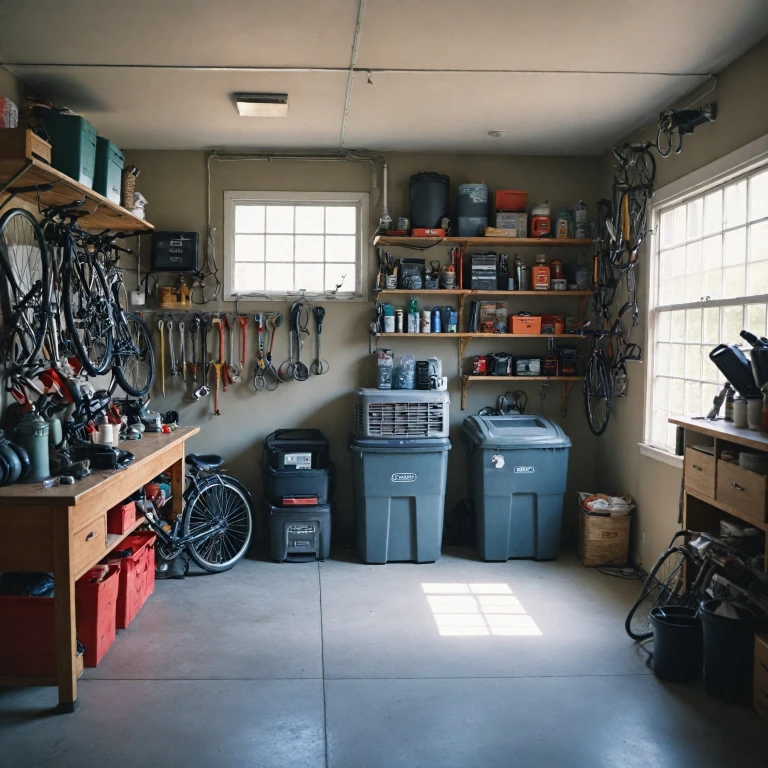Understanding the Need for Garage Cooling
Recognizing the Importance of Cooling Your Garage
Garages often transform into multifunctional spaces, functioning as more than just parking spots. They turn into workshops, storage areas, or even additional living spaces. However, the lack of insulation and ventilation in garages makes them susceptible to extreme temperatures. In the summer, the ambient heat can transform your garage into a sweltering oven, making it an uncomfortable environment for any activity.
Using a portable air conditioner can resolve this issue effectively. These portable units serve as an adaptable solution to combat the intense heat, ensuring your garage remains a usable and comfortable space throughout the year. One key advantage of a portable unit is its ability to be relocated easily, allowing you to optimize your garage setup according to your needs.
With the right portable air conditioning solution, you can transform your garage into a well-cooled, enjoyable space. Whether it's a hobby shop, a gym, or just a place to tinker on your project car, achieving the best unit setup can significantly enhance comfort. This endeavor doesn't just stop at picking any portable unit; you will need to consider how best to install it while ensuring energy efficiency and meeting your budget constraints.
For additional cooling solutions, check out resources on understanding evaporative coolers, as they might provide an alternative or complement to your current setup.
Choosing the Right Portable AC Unit for Your Garage
Factors to Consider When Selecting a Portable AC for Your Garage
Selecting the right portable air conditioner for your garage is crucial to ensure effective and efficient cooling. You'll want to consider several key factors before making a decision:
Size and BTU Capacity
It's important to choose a portable unit with the appropriate British Thermal Units (BTU) capacity to effectively cool your garage space. A unit with too low a BTU will struggle to cool a sizable garage, whereas one with too high a BTU might cool too rapidly without adequately dehumidifying the air, leading to a damp environment. Understand the square footage of your garage to determine the best unit size for your needs.
Portability and Installation
Garage air conditioners should be easy to move and install. Make sure the portable unit comes with caster wheels or handles for mobility. Installation should be straightforward, requiring minimal tools while fitting well with the existing space, especially if you have limited window areas available for venting. Check whether the unit can expand to fit your garage windows or doors.
Energy Efficiency
An energy-efficient air conditioning unit is not only good for the environment but also beneficial for your energy bills. Look for models with an Energy Star rating or features that promote energy savings, like programmable timers or eco modes. This ensures the unit provides effective cooling without a significant increase in costs.
Noise Levels
Consider the noise level of the air conditioner, especially if your garage serves as more than a storage area. If it’s also a workshop or hobby space, a quieter unit will be less distracting, allowing you to focus on tasks at hand without the constant hum of the air conditioner in the background.
Best Placement Practices
Where you position your air conditioning unit affects its efficiency. Place it in an area that facilitates optimal airflow and doesn't obstruct your garage activities. Proper placement also promotes effective distribution of cooled air, ensuring every corner of your garage benefits from the temperature regulation.
For more detailed insights into selecting efficient cooling solutions, you might want to explore
efficient cooling solutions for mobile homes as many of the considerations overlap with garage cooling needs.
Installation Tips for Portable AC Units in Garages
Setting Up the Ideal Cooling Configuration
Ensuring your garage remains a comfortable space with an efficient portable air conditioner requires careful installation. This involves taking into account the unit's BTU capacity, placement, and venting process. Here’s how you can effectively install a portable AC unit in your garage to optimize cooling.
Firstly, selecting an ideal location is crucial. Position the portable unit where air can circulate freely without obstructions. Typically, placing it in a central part of the garage, away from direct sunlight, minimizes heat buildup and enhances performance. Ensure the space around the unit is ample enough for effective air distribution.
A key installation step is managing the exhaust heat. Most portable air conditioners come with a window kit to vent hot air outside. If your garage lacks windows, consider installing a temporary exhaust vent through a low-trafficked wall or near the upper portion of the garage door, maximizing the system's efficiency. Remember, proper installation of the venting system helps prevent the AC unit from recycling hot air, which can significantly impact cooling efficacy.
If a window vent option is not viable, alternatives such as semi-permanent vents or utilizing existing vents should be considered. A mobile exhaust tube can be attached to these alternatives, guiding hot air outside, ensuring the portable unit functions optimally.
Be mindful of the electrical outlet capacity when installing the unit. Ensure the outlet can support the air conditioner without overloading. Consider using a surge protector as an added safety measure against sudden power fluctuations.
To maximize your setup, keep the garage insulated. Seal any gaps or spaces around doors and windows. Also, consider weather stripping around the garage door to prevent excess external heat from entering, maintaining a cooler interior during warm months.
For those considering a more permanent solution, exploring
mini split line sets could also be a viable alternative for effective and efficient climate control in garage spaces.
A thoughtful approach to setting up ensures that your portable AC unit runs efficiently, making your garage a comfortable retreat or workspace regardless of the season.
Energy Efficiency and Cost Considerations
Balancing Power and Efficiency
When it comes to using a portable air conditioner in your garage, understanding energy efficiency and cost considerations is key. The BTU rating is a critical factor; it determines how well the unit will cool the space. For a typical two-car garage, you'll want a unit with at least 10,000 to 12,000 BTUs. However, if the space is larger or if there is direct sunlight, a higher BTU might be necessary.
Cost considerations don’t stop at the unit’s purchase price. While portable air conditioners tend to be less expensive upfront compared to alternatives like mini splits, ongoing energy costs can add up. Look for units with high energy efficiency ratings to minimize electricity bills. Energy Star-rated units are generally a good bet for those looking to save on energy costs.
Utilize Setting Adjustments
Many modern portable units come with energy-saving features, such as programmable thermostats, sleep settings, or timers, so you only use energy when needed. Investing in a unit with these features can significantly reduce operational costs. Additionally, consider placing the unit closer to where you spend most of your time in the garage, optimizing the cooling effect.
Evaluate the Installation Impact
Sealing any gaps like those in a window unit is also essential. If your unit requires a window for venting, ensure it’s properly sealed. This not only keeps the air in but also ensures that the portable unit operates efficiently. An improperly sealed window can lead to energy wastage, as the cool air escapes the garage.
Monitor and Manage Regular Use
Monitoring your portable air conditioner's performance is crucial. Regular maintenance can prevent the unit from overworking, which can lead to costly repairs and inefficient cooling. This includes routinely cleaning or replacing filters to ensure optimal air flow.
Choosing the best unit for your needs and properly managing it ensures you’ll effectively cool your garage while keeping energy use and costs in check.
Maintenance and Troubleshooting Tips
Ensuring Longevity and Optimal Performance
Proper maintenance is essential to keep your portable air conditioner running efficiently in your garage space. Neglecting regular upkeep can lead to decreased performance and a shorter lifespan. Here are some tips to help maintain your unit:
- Clean the Filters Regularly: Like any air conditioning unit, your portable unit's filters should be cleaned or replaced regularly. Dust and debris can clog the filters, hindering airflow and reducing cooling efficiency.
- Check for Obstructions: Ensure that nothing is blocking the inlet and outlet of your portable AC. Obstructions can lead to increased energy consumption as the unit works harder to cool the space.
- Inspect the Exhaust Hose: Over time, the exhaust hose can accumulate dust and build-up. Make sure to inspect and clean it to prevent blockages that can lead to overheating and reduced cooling output.
- Monitor Condensate Drainage: Some units offer automatic evaporation systems, but others may require manual drainage. Ensure your portable air conditioner's condensate tank or drainage system is functioning properly to avoid leaks.
- Schedule Regular Check-Ups: A routine inspection by a professional can help identify potential issues with your air conditioner before they become serious problems. This is particularly beneficial if you use your unit often in a workshop or garage.
Regular maintenance coupled with timely troubleshooting will not only ensure that your garage remains cool and comfortable but also extend the life of your portable air conditioner. By keeping these tips in mind, you will maximize the efficiency of your unit, allowing you to make the most of your cooling investment even as temperatures rise.
Maximizing the Benefits of a Portable AC Unit in Your Garage
Enhancing your garage cooling solution
Maximizing the benefits of your portable air conditioner in a garage involves more than just turning it on and letting it run. After selecting the best unit for your garage space, you will want to ensure that every aspect of your setup is optimized for efficient cooling. Here's how you can make the most out of your portable unit.
- Optimize air flow: Make sure that the portable unit's exhaust hose has a clear path to a garage window or a cut-out in the garage door. Proper ventilation is key; a blocked airflow, whether from outside factors or an over-reliance on one window unit, can significantly reduce your unit's effectiveness.
- Seal gaps: Check for any gaps or cracks around the garage door, windows, or walls. Unwanted air transfer will compromise the cooling efficiency. Using weather stripping or caulk can help maintain the desired temperature within the garage by minimizing heat exchange.
- Portable unit placement: Position the portable AC unit strategically within the garage. Avoid placing it in direct sunlight or surrounded by heavy objects that could block airflow. A closer proximity to your workspace will ensure quicker and more effective cooling.
- Pay attention to BTU rating: Ensure that the capacity of your air conditioner aligns with the size of your garage. A higher BTU rating will be necessary for larger garages or those with high ceilings.
- Consider additional insulation: If the portable air conditioner isn’t enough, consider adding temporary insulation solutions like reflective barriers. This helps in reducing the heat load entering the garage.
- Use fans to expand cooling: Incorporating fans can assist in circulating the cooled air throughout the entire room, making the environment more comfortable, especially if you are using your garage as a shop or workspace.
By following these tips, you not only enhance the cooling power of your portable air conditioner but also contribute to energy efficiency. Ensuring that your cooling solutions are effectively implemented will allow for a garage space that is both comfortable and functional, no matter the external temperatures.

